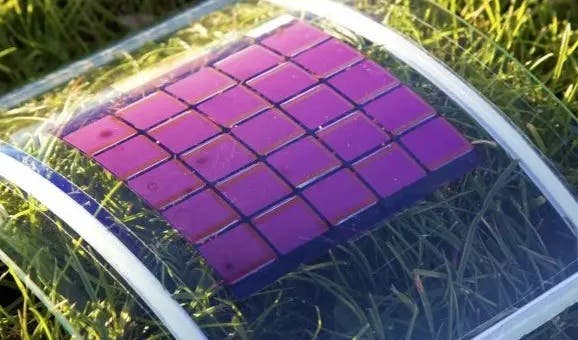Groundbreaking discovery makes organic solar cells significantly more efficient
Solar energy stands at the forefront of sustainable energy solutions and could meet global energy demands with minimal environmental impact

[Oct. 21, 2023: Staff Writer, The Brighter Side of News]
Solar energy stands at the forefront of sustainable energy solutions and could meet global energy demands with minimal environmental impact. (CREDIT: Creative Commons)
The relentless pursuit of more efficient solar energy harnessing takes a promising turn as researchers at the Technical University of Munich (TUM) make a groundbreaking discovery. Their research highlights the role of specific organic dyes in creating 'super-highways' for faster, more efficient energy transport in organic solar cells, marking a significant stride towards optimized solar energy conversion.
Solar energy stands at the forefront of sustainable energy solutions, offering an abundance of power that, if harnessed effectively, could meet global energy demands with minimal environmental impact.
However, a significant challenge lies in the loss of energy as it journeys through solar cells—a hurdle particularly prominent in the realm of organic solar cells. These cells, notable for their lightweight, flexibility, and suitability for coating diverse surfaces, encounter a critical drawback: the inefficiency in transporting the captured solar energy within the material.
To appreciate this breakthrough, it's vital to understand how solar energy is captured and converted. The sun bombards Earth with immense energy, a fraction of which is absorbed by solar cells and converted into electricity. This process hinges on the ability of the cells to absorb photons from sunlight and generate excitons—energy packets crucial for electricity generation.
Related Stories
Professor Frank Ortmann, a leading researcher in Theoretical Methods in Spectroscopy at TUM, elaborates, "Excitons are something like the fuel of the sun, which has to be used optimally. When light energy in the form of a photon collides with the material of a solar cell, it is absorbed and buffered as an excited state.
This intermediate state is referred to as an exciton." These excitons are then obligated to travel swiftly within the solar cell material to a specially designed interface, where they're converted into usable electrical energy.
The Dilemma of Energy Transport:
Despite their potential, organic solar cells historically suffer from subpar performance due to the slow and inefficient transport of these excitons. This inefficiency stems from the excitons' short lifespan, necessitating a rapid, targeted transport to prevent energy loss.
HOMO and LUMO structures obtained from DFT calculations (M06-2X/cc-pVTZ). b, d Top view and side view of the QM1 crystal structure. Unit cell is indicated in blue. c Photograph of a QM1 crystal. e Arrangement of transition dipole moments (red arrows) relative to the molecules in the crystal structure. (CREDIT: Nature)
"The faster and more targeted the transport, the higher the energy yield, and thus the higher the efficiency of the solar cell," Professor Ortmann explains, underscoring the urgency of optimizing this aspect of organic solar cell functionality.
The Role of Organic Dyes in Solar Cells:
Enter the game-changing role of organic dyes, specifically quinoid merocyanines. These dyes, distinguished by their molecular structure and exceptional light-absorbing properties, have emerged as the linchpin in enhancing exciton transport. They serve a dual purpose: absorbing light to create excitons and forming 'highways' along which these excitons can race toward the conversion interface. Their suitability for use as the active layer in organic solar cells positions them as a pivotal element in the evolution of solar energy technology.
Low-energy exciton band structure Ev(q) along the directions between special points in the Brillouin zone. The exciton band structure of the pure Frenkel model is plotted as a solid line and the exciton band structure including Frenkel (FE) and charge transfer (CT) excitons is plotted in dashed lines. (CREDIT: Nature)
Through meticulous spectroscopic measurements and theoretical models, the TUM research team observed excitons traversing the material at unprecedented speeds. "The value of 1.33 electron volts delivered by our design is far above the values found in organic semiconductors – you could say the organic dye molecules form a kind of super-highway," Ortmann shares with palpable excitement.
The Implications for Future Energy Solutions:
These findings are more than just incremental progress; they represent a paradigm shift in the understanding and manipulation of energy transport within organic solar cells. The implications extend beyond merely improved solar panels. Envision flexible, roll-up solar films, or solar cells seamlessly integrated into the surfaces of smart devices, all operating at efficiencies that make them viable alternatives to conventional energy sources.
Comparison of 1D excitonic material QM1 with other molecular systems, namely 2D herring-bone (HB) oligomers and acenes and related compounds, which are also arranged in an HB fashion. (CREDIT: Nature)
Furthermore, the research opens avenues for innovations in organic light-emitting diodes (OLEDs) and other technologies reliant on efficient exciton transport, potentially revolutionizing displays, lighting, and a spectrum of other applications.
The journey toward a cleaner, sustainable energy future is fraught with challenges, but discoveries like that made by Professor Ortmann and his team illuminate the path forward. By harnessing the power of organic dyes to expedite exciton transport, we edge ever closer to maximizing the sun's generous energy offering, mitigating our environmental footprint, and fostering a world where the full spectrum of human innovation shines as brightly as the solutions we seek to uncover.
Note: Materials provided above by The Brighter Side of News. Content may be edited for style and length.
Like these kind of feel good stories? Get the Brighter Side of News' newsletter.
Joseph Shavit
Head Science News Writer | Communicating Innovation & Discovery
Based in Los Angeles, Joseph Shavit is an accomplished science journalist, head science news writer and co-founder at The Brighter Side of News, where he translates cutting-edge discoveries into compelling stories for a broad audience. With a strong background spanning science, business, product management, media leadership, and entrepreneurship, Joseph brings a unique perspective to science communication. His expertise allows him to uncover the intersection of technological advancements and market potential, shedding light on how groundbreaking research evolves into transformative products and industries.



